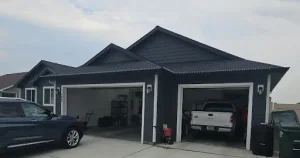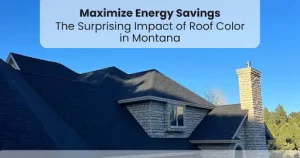In the heart of Montana, where the climate swings from chilly winters to warm summers, homeowners often face a dilemma they might not even realize choosing the right roof color. Imagine this: Your neighbor repaints their roof, and suddenly their energy bills drop.
What changed?
It wasn’t just aesthetics; it was the color of their roof. In Montana, where every season brings a unique challenge, the color of your roof can significantly impact your home’s energy efficiency, saving you money in the long run. Let’s explore how a simple color choice can make all the difference.
Understanding the Connection: Roof Colors and Energy Efficiency
When you think about energy efficiency, insulation and HVAC systems might be the first things that come to mind. However, the color of your roof plays a surprisingly vital role in how energy-efficient your home can be. This is because different roof colors have varying abilities to reflect or absorb sunlight.
How Roof Color Affects Energy Consumption
Roof colors can either reflect or absorb sunlight. Lighter colors, like white, tend to reflect more sunlight, keeping your home cooler during the summer. Conversely, darker colors, such as black or dark gray, absorb more heat, which can be beneficial during Montana’s cold winters but detrimental in the summer.
For residents in Bozeman, where summers can get warm and winters harsh, selecting the right roof color is a balancing act. The right choice can reduce your reliance on air conditioning and heating, ultimately leading to lower energy bills.
Best Roof Colors for Montana’s Climate

White Roof: A Cooler Choice for Hot Summers
A white roof is often considered one of the best choices for hot climates because it reflects up to 90% of sunlight. In cities like Billings, where summer temperatures can rise, a white roof can significantly reduce cooling costs. By reflecting sunlight, a white roof can help keep your attic and home cooler, reducing the strain on your air conditioning system.
Key Benefits of a White Roof:
- Reflects sunlight and heat, keeping your home cooler.
- Reduces cooling costs in the summer.
- Can extend the lifespan of your roof by reducing thermal stress.
Dark Roof: Warmth in the Winter
In contrast, dark roofs are excellent for colder climates because they absorb more heat. This heat absorption can help reduce heating costs during Montana’s frigid winters. However, the downside is that they can also lead to higher cooling costs in the summer.
Key Benefits of a Dark Roof:
- Absorbs heat, which can reduce heating costs in winter.
- Suitable for colder areas like Bozeman.
- Adds a traditional aesthetic to your home.
Which Roof Colors Can Save You Money on Energy Bills?
The best roof color for energy efficiency depends on the specific climate conditions you face. A balance is crucial in Montana, where you need to consider both cold winters and warm summers.
The Best Roof Color for a Hot Climate
In warmer months, lighter roof colors are generally more energy-efficient. White roofs are especially effective at reflecting sunlight, which can help keep your home cool during the hot summer months in Billings and Bozeman. If you live in a part of Montana where summers are particularly intense, choosing a lighter roof color could lead to significant energy savings.
The Best Roof Color for Heat Retention
If you’re more concerned about keeping your home warm during Montana’s chilly winters, a darker roof might be a better choice. Dark roofs absorb more sunlight, which can help reduce your reliance on heating systems during the colder months. This can be particularly beneficial in Bozeman, where winter temperatures can drop significantly.
Roof Color Combinations: Customizing for Your Needs
Some homeowners opt for a roof color that strikes a balance between cooling in the summer and heating in the winter. For instance, a medium-gray roof could provide some reflective benefits while still absorbing enough heat to keep your home warm during colder months. Additionally, exploring roof color combinations that complement your home’s exterior can enhance both energy efficiency and curb appeal.
Why Roof Color Matters in Energy Efficiency
Your roof color is more than just a design choice; it’s a decision that impacts your home’s energy efficiency, comfort, and even your wallet. Selecting the right color can lead to significant energy savings, while the wrong choice could result in higher utility bills.
Best Roof Color for Hot Climate
In regions with hot climates, lighter roof colors are typically the best choice. They reflect more sunlight, reducing the amount of heat that enters your home. This results in lower cooling costs and a more comfortable indoor environment.
Best Roof Color for Heat Retention
For colder climates, darker roof colors are preferable because they absorb more heat. This can help reduce heating costs during the winter months. In Montana, where winters are long and cold, a dark roof can make a significant difference in energy consumption.
For more insights into choosing the best roofing options, check out our previous blog on Energy-Efficient Roofing Options in SD.
Choose Wisely, Save Wisely
Choosing the right roof color is more than just a matter of aesthetics. It’s a decision that can significantly impact your energy bills and overall comfort. In Montana, where the climate varies dramatically between seasons, it’s crucial to select a roof color that suits both your local weather and your energy efficiency goals. Whether you opt for a light, reflective color to keep cool in the summer or a darker hue to absorb warmth in the winter, the right choice can lead to substantial savings.
If you’re looking to make the best decision for your home, consider all these factors and consult with local experts who understand Montana’s unique climate. Remember, your roof color does matter—so choose wisely and enjoy the energy savings.
Quick Answers for Homeowners
What Color Roof is Best for Energy Efficiency?
The best roof color for energy efficiency depends on your climate. In warmer areas like Billings, a lighter roof is ideal for reflecting heat. In colder areas like Bozeman, a darker roof can help retain warmth.
What is the Best Color Roof to Reduce Heat?
White or light-colored roofs are the best for reducing heat as they reflect most of the sunlight, keeping your home cooler in the summer.
What Color Roof is Eco-Friendly?
An eco-friendly roof color would be one that reduces your energy consumption, such as a light-colored roof in hot climates, which lowers the need for air conditioning.



